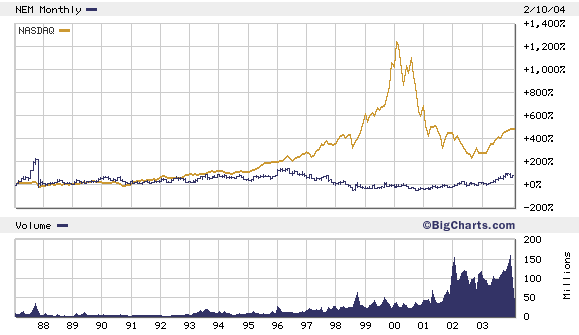Election issue watch: outsourcing. Greenspan and the Chairman of the White House Council of Economic Advisers don't believe outsourcing is an economic problem. It may be a political one, though.
First, economically, it's not clear yet what the long-term impact of outsourcing will be. Short term, according to a Bloomberg article, "
Over the next 15 years, 3.3 million U.S. service-industry jobs and $136 billion in annual wages will move to India, the Philippines, China and Malaysia, among other countries, according to a study by Forrester Research Inc., a Cambridge, Massachusetts, consulting company."
That's 3.3 million in addition to whatever manufacturing jobs are displaced. Of course an economy is always gaining and losing jobs. Ideally, jobs are created in those industries an economy has a comparative advantage in. For example, as computing and technology become more pervasive, you'd expect more jobs in new technology related-fields or in other parts of the economy that use technology in new ways. This is sort of a second-generation, more sober "new economy idea that recognizes today's technology is just a tool, not and end.
However, despite the promises of bio-tech, nano tech, silicon chips, etc...we simply haven't seen this yet. Yet. Will we? I don't' know.
In the short-term, to those who've lost their jobs (and have a vote) the loss of jobs looks more like a major decline in living standards of living than the sign of a "dynamic economy." Not so, said the Chairman of the Federal Reserve in his testimony to the Senate last week, "
What will ultimately determine standard of living of this country is the skill of the people.''
Workers, after all, aren't machines. A human being can't be made obsolete because he loses his job. He may have to train for a new job and adjust. But that happens all the time in an economy. And in truly competitive economies, workers adjust and gravitate toward the higher wage jobs.
That's the theory, anyway. In reality, the missing component to the theory is the lack of new job creation in the United States. Maybe it's coming. Maybe we really are on the cusp of robust, tech-driven, work-force transforming boom. We simply don't know.
This a new development in global trade, where jobs become a commodity and move across borders as easily as lumber, pomegranates, or scrap metal. If labor is commodified (employers get the most skill at the cheapest cost because of a competitive labor market), it should lead to generally lower prices, which you'd think would be good for consumers.
But even if the world were approaching a golden age of a price stability, you'd have the problem of income instability. As the job market gets shuffled, a lot of workers get "displaced." And until the new job-producing industries make themselves known, you're going to find an awful lot of disaffected, displaced workers/voters. They won't have time for the subtleties of macro-economic labor market theory, and unproven theory at that.
But they WILL understand the emotional logic of a growing "wage gap." And they'll want it closed. With tariffs.
My guess, Kerry introduces the idea of tariffs into his campaign, or simply names Dick Gephardt as his running mate. At a debate sponsored by Pace University in September of last year, Gephardt said, "
We need to have a policy to build new jobs in this country. Part of it is fair trade, not just free trade. Most everybody here voted for NAFTA, voted for the China agreement. I did not. I led the fight against it. That's the kind of trade policy we need that globalizes with fairness and standards around the world so work, wherever it's performed, is given a fair wage for their hard work."
First, it looks like a throw away line, but a "policy to build new jobs." Hmm, how about the free market? Second, what is "fair trade?" I'm guessing the kind that doesn't cost American jobs but provides cheap goods. But I'm sure we'll find out soon.
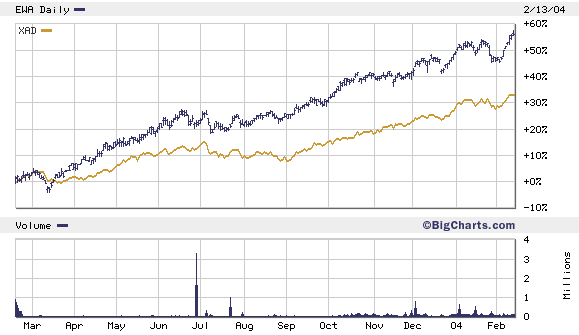
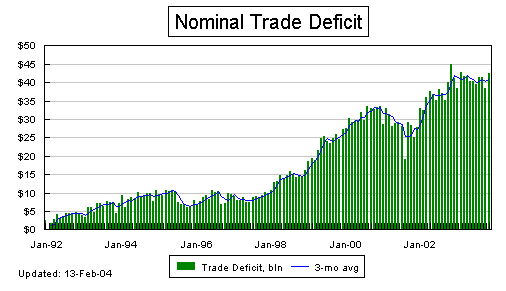
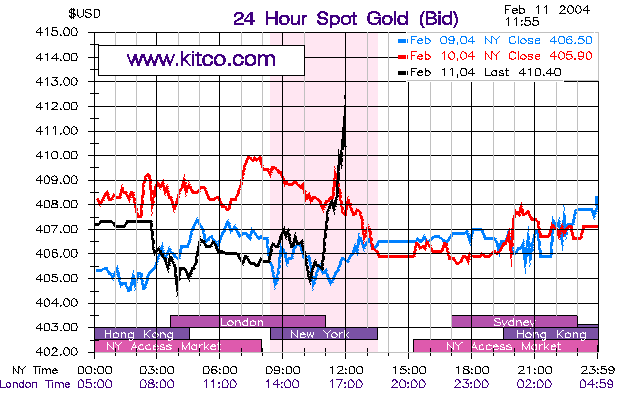 ...and the Dow
...and the Dow
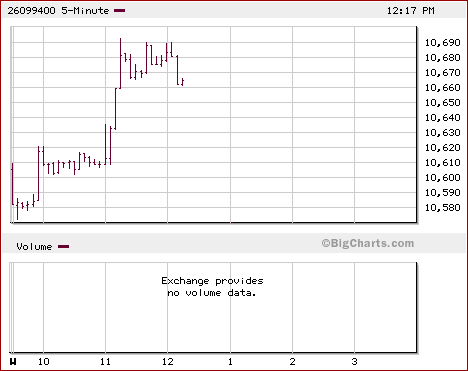 "
"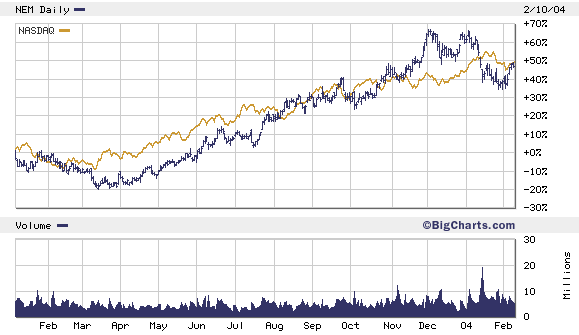 Not so fast, my friend. Let's put our bull (and bear markets) in perspective. Gold is coming off a 20-year bear. It's performance in the last year is the initial stage of what I think is a multi-year bull. Like all stocks, gold stocks can get ahead of earnings. But gold companies are in the business of mining a commodity (and monetary asset) that's increasingly demand. Business is good.
On the other hand, the Nasdaq is the George Foreman of indexes. It's taken some big blows. And though it looks sturdier now than a year ago, it's really just one year older, one year fatter, and one year more bloated. As you can see from the chart below...this is a tale of two bull markets. One that's dead and bouncing...and one that's alive and growing.
Nasdaq vs. Newmont, 1987 to present
Not so fast, my friend. Let's put our bull (and bear markets) in perspective. Gold is coming off a 20-year bear. It's performance in the last year is the initial stage of what I think is a multi-year bull. Like all stocks, gold stocks can get ahead of earnings. But gold companies are in the business of mining a commodity (and monetary asset) that's increasingly demand. Business is good.
On the other hand, the Nasdaq is the George Foreman of indexes. It's taken some big blows. And though it looks sturdier now than a year ago, it's really just one year older, one year fatter, and one year more bloated. As you can see from the chart below...this is a tale of two bull markets. One that's dead and bouncing...and one that's alive and growing.
Nasdaq vs. Newmont, 1987 to present
